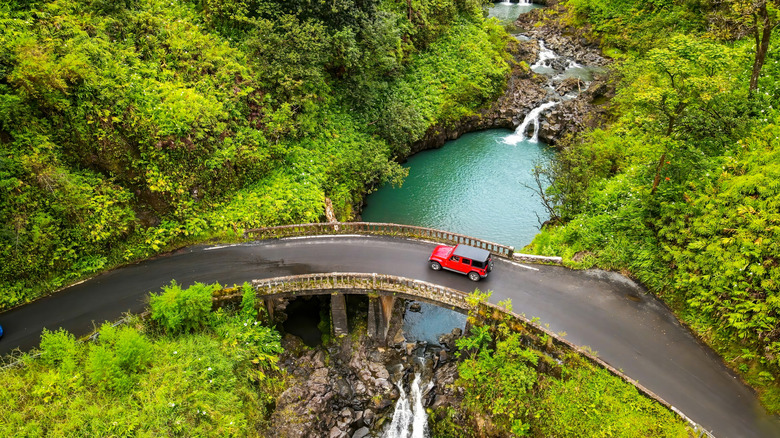This Stunning Destination In Maui Boasts Mesmerizing Black And Red Sand Beaches
While famously known as America's 50th state, Hawaii is more than just sun, sand, and relatively young statehood. A land of ancient kingdoms and living traditions, its people embody a culture that has long lived in harmony with nature. From the ancient legends examined and celebrated in Disney's blockbuster "Moana" to the unflinching portrayal of pre-colonial Hawaii in Apple TV's current cinematic thrill ride "Chief of War," Hawaii's legendary islands remind solo travelers and global audiences alike that the archipelago's storied and important past began long before statehood.
Hana, known as the "Heart of Old Hawaii," is an integral part of the islands' story. Tucked along Maui's remote eastern shore, Hana is a secluded ancient enclave that still celebrates the rich history and cultural diversity of Maui. With striking, otherworldly landscapes and coastlines, the area has long been the backdrop to major motion pictures and highly rated TV shows, including "Lord of the Flies," "Fantasy Island," and "The Amazing Race."
A dominant part of these stunning landscapes lies just beyond Hana's rugged borders. Wai'anapanapa State Park, a wild, untamed paradise defined by lava caves, blowholes, and jagged cliffs, is an imposing force that draws visitors to its raw natural power and dramatic terrain. Its infamous black sand beaches, along with the nearby, almost inaccessible red sands of Kaihalulu Beach, stand as eternal traces of the volcanic activity that thrust the Hawaiian archipelago from the haunting depths of the ocean floor many millennia ago.
Natural wonders define the infamous 'Road to Hana'
To visit Hana, you'll need to fly into Kahului Airport (OGG), Maui's major airport, and then travel by car to the island's eastern coast. Stretching a distance of over 50 miles from the airport, and an infamous attraction in its own right, the "Road to Hana" hugs Maui's rugged coastline and is defined by hairpin turns, narrow bridges, and difficult driving conditions. Along the way, you'll maneuver through more than 600 curves and nearly 60 bridges. The road is also flanked by all the natural wonders you'd expect from Hawaii's wild landscapes, including lush rainforests, imposing rock formations, and a variety of water-centric elements, including cascading waterfalls, natural pools, and vast seascapes.
Among Hana's most striking attractions are its black and red sand beaches. Stretching across 122 acres of coastline in Wai'anapanapa State Park, the stunning black sand beach is worth a stop, with visitors also able to explore nearby blowholes and sea caves, take a dip in a secluded natural swimming pool, and even visit ancient Hawaiian burial sites. While it is possible to lie on the park's alluring black sand beach, advanced reservations are required. Meanwhile, the singular trail to the red sands of nearby Kaihalulu Beach is washed out and extremely dangerous, while also passing through private property, making the beach itself inaccessible. That said, you can still capture captivating images of the mysterious red-sand cove from the hills surrounding Kauiki Head.
While exploring Wai'anapanapa State Park, visitors can picnic, camp, birdwatch, visit a heiau temple, and even follow an ancient trail that hugs the craggy coastline and leads avid hikers into Hana. Given the town's relatively secluded location and notoriously hard-to-traverse roads, travelers are encouraged to visit the area through a permitted tour with a reputable company.
What to do in and around Hana
The town of Hana is filled with quaint shops, unique art galleries, local restaurants, and numerous businesses and attractions that offer glimpses into its diverse cultural heritage. Open upon special request, Hana's Cultural Center and Museum sits at the heart of the small town. Established by several of the community's elders, the museum houses the town's 19th-century courthouse, as well as several exhibitions and artifacts showcasing Maui's and greater Hawaii's rich history. The grounds are also home to an ethnobotanical garden, which features some of Hawaii's rarest ancient plant species.
True to Hawaii's wild nature, water activities can also be enjoyed throughout the small town. Hana Bay is one of the area's most popular snorkeling destinations, with prime water conditions happening in the spring and summer. The bay's protected placement along the coastline makes it an ideal location for underwater adventurers of all experience levels to discover a variety of fish species and sea turtles, and it is also home to humpback whales, which migrate through the area from winter to early spring.
Hana's Hamoa Beach is a popular surf destination and is considered one of the cleanest beaches on the island. If you're lucky, local legend suggests you may even catch a glimpse of the Hawaiian Goddess Pele walking her dog along Hamoa's shoreline after the sun sets. To avoid peak crowds, the fall is the best time of year to visit Maui. And before you wrap up your time on the island's wild east coast, head to Haleakala National Park in Kipahulu. Just 10 miles from Hana, the park's Pipiwai Trail marks the entrance to the 400-foot Waimoku Falls, considered one of Maui's best waterfalls.


